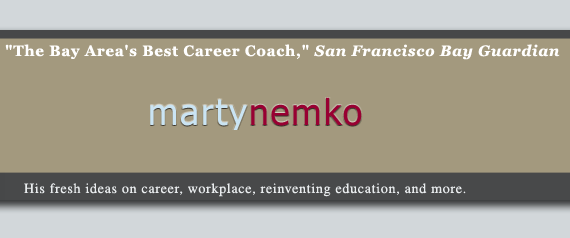Your Independence Day
By Marty Nemko
Financial independence is near the top of most people’s wish lists. Alas, it’s near the bottom of most people’s attainability list.
Here’s my best shot at boosting your odds.
If someone told me, “If you don’t earn a million dollars in five years, I’ll blow your brains out,” this is what I’d do. And I wouldn’t need to break any laws.
All I need is about $10,000 in starting capital. If I didn’t have it, I’d get a loan from family, friends, or find a credit card with a low loan rate. Right now, the nation’s best deal may be at Pulaski Bank (http://www.pulaskibank.org/index.cfm?afid=999. It offers a 7.99% rate on cash advances (and no other fees) plus a 0% rate on all balance transfers.
I’d use that money to start one of the world’s most old-fashioned businesses: selling from a cart.
Worried about the lack of status? That you’ll have to tell your friends you’re a pushcart vendor? Nah. Tell ‘em you’re the president and CEO of the Continental Cappuccino Corporation with 15 branches throughout the metropolitan area.
What would I sell? My first requirement is that the product adhere to Google’s corporate principle: “Do no evil.” So, no cigarettes, drug paraphernalia, or so-called collector’s knives. Beyond that rule, I’d be open to anything that sells well, year in and year out, despite a high profit margin: scarves, fancy soaps, burritos, sunglasses, cosmetics, or espresso, for example.
Of course you can overpay, but if you search, you can buy your product for a few cents on the dollar. I know a guy who pays 50 cents for a bar of French soap (bought directly from the manufacturer) and sells it for $6.00. Silk scarves, high-quality makeup, or in-style sunglasses bought right can cost you a buck a piece and you can sell it for $10. That double espresso you just spent $3.50 for probably cost the storeowner 20 cents.
Where would I put my cart? In a high-foot-traffic location that I had to pay little or no rent for—for example, on a busy street corner next to a major bus or train station in a location laden with high-discretionary-income people. Of course, most such locations require government approval. Other good locations: the lobby of a busy office building or hospital. You may be able to convince the landlord to let you be there free, because it isn’t expected that the lobby will generate income, yet the business, say, your Grand Grounds espresso cart located in a hospital, provides doctors and nurses with their jolt of just-perfect java without their having to brave the elements. And who knows, it might keep a sleep-deprived intern from killing a patient.
No matter how difficult it is to find a dream location, don’t compromise. That one-time investment of time will make or break your business.
But you ask, how can you make a million dollars in five years from a cart? You can’t. But you probably can make a million bucks from five to 20 carts. The key to successful business: perfect a formula for a business that can reliably net $20,000-$50,000 a year and then keep cloning it in a different location until you’ve made all the money you need.
It’s wise to know when to stop. No one really needs more than $200,000 a year. Beyond that, not only are you paying more than 50% of your additional earnings in taxes, you’re running a more complex operation, which means that more can go wrong. Besides, do you really want to spend 70 hours a week, in perpetuity, running a cart business? Know when enough is enough. At the $200,000 mark, if you really think you want to make more money, franchise the business, or sell it, and start a different small, simple venture.
On this July 4th, it’s a good time to remember that America still is the land of opportunity—if you forgo self-employment for employment, status for simplicity, replication for innovation. If you do, perhaps a few July 4ths from now, along with America’s independence, you’ll be celebrating your own.
© Marty Nemko 2004-2025. Usage Rights

